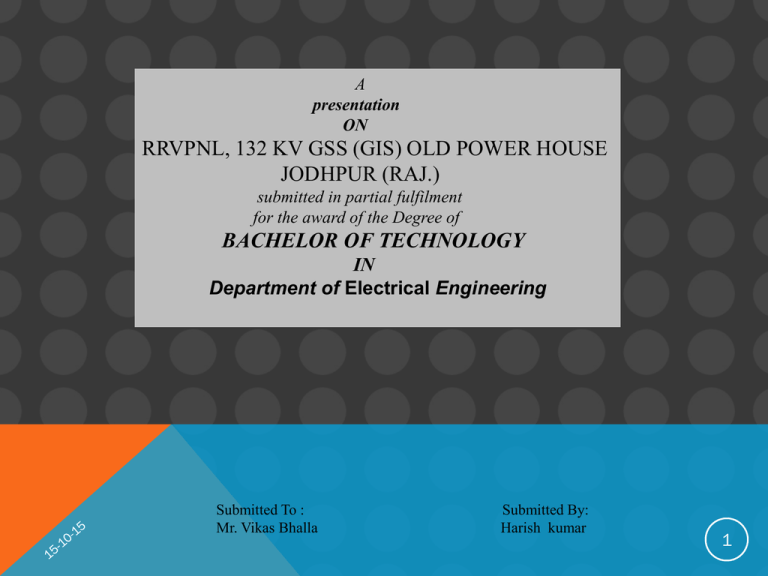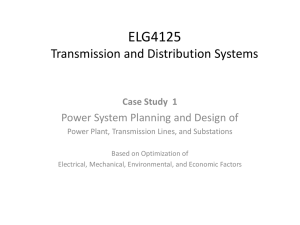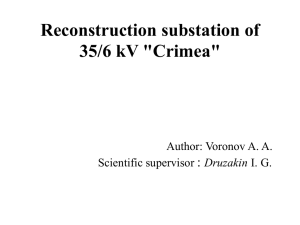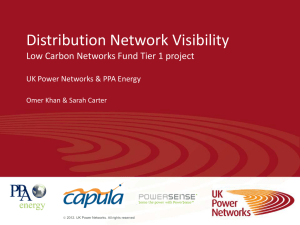gas insulated substation
advertisement

A presentation ON RRVPNL, 132 KV GSS (GIS) OLD POWER HOUSE JODHPUR (RAJ.) submitted in partial fulfilment for the award of the Degree of BACHELOR OF TECHNOLOGY IN Department of Electrical Engineering Submitted To : Mr. Vikas Bhalla Submitted By: Harish kumar 1 GAS INSULATED SUBSTATION B Y: HA R I SH K UM A R ELECTRICAL E NGI N E E R I N G 1510-15 2 3 4 5 CONTENTS: Substation Conventional substations (AIS) Limitations of AIS The need for GIS Introduction to GIS Properties of SF6 GIS assembly Advantages of GIS Design features Drawbacks SF6 – Environmental concerns SF6 /N2 mixtures Future trends in GIS Conclusion. 6 SUBSTATION: • An assembly of apparatus installed to control transmission and distribution of electric power. A:PRIMARY POWER LINES' SIDE B:SECONDARY POWER LINES' SIDE 1.PRIMARY POWER LINES 2.GROUND WIRE 3.OVERHEAD LINES 4.TRANSFORM ER FOR MEASUREMENT OF ELECTRIC VOLTAGE 5.DISCONNECT SWITCH 6.CIRCUIT BR EAKER 7.CURRENT TRANSFORMER 8.LIGHTNING ARRESTER 9.MAIN TRANSFORMER 10 .CONTROL BUILDING 11.SECURITY FENCE 12.SECONDARY POWER LINES 7 AIR INSULATED SUBSTATION(AIS): Air used as a dielectric. Normally used for outdoor substations. In very few cases used for indoor substations. Easy to expand (in case that space is not an issue) Excellent overview, simple handling and easy access. 8 LIMITATIONS OF AIS: Large dimensions due to statutory clearances and poor dielectric strength of air. Insulation deterioration with ambient conditions and susceptibility to pollutants. Wastage of space. Life of steel structures degrades. Seismic instability. Large planning & execution time. Regular maintenance of the substation required. 9 INTRODUCTION TO GAS INSULATED SUBSTATION What is GIS? A gas insulated substation is an electrical substation in which the major structures are contained in a sealed environment with sulfur hexafluoride gas (SF6) as the insulating medium. Where and why Gas Insulated Substations are used ? Gas Insulated Substations are used where there is space for providing the substation is expensive in large cities and towns. In normal substation the clearances between the phase to phase and phase to ground is very large. Due to this, large space is required for the normal or Air Insulated Substation (AIS). But the dielectric strength of SF6 gas is higher compared to the air, the clearances required for phase to phase and phase to ground for all equipments are quite lower. Hence, the overall size of each equipment and the complete substation is reduced to about 10% of the conventional air insulated substation 10 THE NEED FOR G.I.S: Non availability of sufficient space. Difficult climatic and seismic conditions at site. Urban site (high rise building). High altitudes. Limitations of AIS. 11 GAS INSULATED SUBSTATION: Introduction: Compact, multi-component assembly. Enclosed in a ground metallic housing. Sulphur Hexaflouride (SF6) gas – the primary insulating medium. (SF6) gas- superior dielectric properties used at moderate pressure for phase to phase and phase to ground insulation Preferred for voltage ratings of 72.5 kV, 145 kV, 300 kV and 420 kV and above. Various equipments like Circuit Breakers, Bus-Bars, Isolators, Load Break Switches, Current Transformers, Voltage Transformers, Earthing Switches, etc. housed in metal enclosed modules filled with SF6 gas. 12 PROPERTIES OF SF6: • • • N O N - T O X I C , V E R Y S T A B L E C H E M I C A L LY. • I N S U L AT I N G P R O P E R T I E S 3 - T I M E S T H AT OF AIR. • • • MAN-MADE. LIFETIME – VERY LONG (800 TO 3200 YEARS!). C O LO R L E S S & H E AV I E R T H A N A I R . A L M O S T W AT E R I N S O L U B L E . NON INFLAMMABLE. 13 Kalisindh Thermal Power 14 GIS ASSEMBLY: ESSENTIAL PARTS OF GIS: 1. Bus bar 2. Circuit Breaker 3. Disconnector (line or bus) 4. Earthing switch (line or bus) 5. Current transformer (feeder / bus) 6. Voltage transformer (feeder/ bus) 7. Feeder Disconnector 8. Feeder Earthing switch 9. Lightning / Surge Arrester 10. Cable termination 11. Control Panel. 15 BUS BAR When a number of lines operating at the same voltage have to directly connect electrically bus bar are used as the common electrical component. There are following bus at the 132 gss:• 132 kv main bus bar • 132 kv auxiliary bus bar ISOLATOR Isolator is used to break the circuit under off-load where as on-load circuit breaking is done by circuit breaker Isolators are classified as:• Off load isolator • On load isolator 16 17 CIRCUIT BREAKER An automatic switch that stops the flow of electric current in a suddenly overloaded or otherwise abnormally stressed electric circuit. Types of circuit breaker:• Vaccum circuit breaker • SF6 Circuit breaker • Air blast circuit breaker • Oil circuit breaker 18 CIRCUIT BREAKER OPERATION MECHANISM 19 INSULATOR Barrier insulator: The GIS is sectionalized into individual gas compartments by means of gas-tight barrier insulators. By this, the impact of extension or internal faults on the overall installation is reduced to a minimum, and control, supervision and maintenance are greatly eased. All flange connections are sealed by means of age-resistant O-rings. Due to the gas tight design of the insulators no leakage between components can occur. Support insulator: Support insulators are used to mechanically support the conductors. They mainly used for long SF6 bus duct connection. 20 21 22 CURRENT TRANSFORMER Current transformer is used for measurement of alternating electric current. The objective of C.T. is :Reduce the scale of the metering scale. Insulated the measuring instrument from voltage. • Used for protective system 23 24 POTENTIAL TRANSFORMER Potential transformer is used for step down the line voltage. PT is connected in prallel with line. Secondary voltage of the PT is generally 110v. 25 CAPACITOR VOLTAGE TRANSFORMER A capacitor voltage transformer consists of a Capacitor Voltage Divider (CVD) and an inductive Intermediate Voltage Transformer (IVT). The rated voltage of the complete capacitor voltage transformer determines the ratio at the capacitor voltage divider. It is more convenient to make an Inductive voltage transformer for lower voltage levels and let the CVD take care of the high voltage. 26 LIGHTENING ARRESTER 27 LIGTHNING ARRESTOR Lightening arrester is used to protect the power station sub station and transmission line against the voltage wave reaching there. It is also known as surge diverter which is connected between line and earth to divert the incoming high voltage to earth. It is the first equipment in a substation. Generally arresters are connected in parallel with the equipment to be protected, typically between phase and earth for three phase installations. 28 29 GIS ASSEMBLY: 30 Supervisory Control And Data Acquisition (SCADA) Supervisory Control and Data Acquisition (SCADA) offers the ease of monitoring of sensors placed at distances, from one central location. SCADA systems are used to monitor and control a plant or equipment in industries such as telecommunications, water and waste control, energy, oil and gas refining and transportation. A SCADA system gathers information, such as where a leak on a pipeline has occurred, transfers the information back to a central site, alerting the home station that the leak has occurred, carrying out necessary analysis and control, such as determining if the leak is critical, and displaying the information in a logical and organized fashion. SCADA systems can be relatively simple, such as one that monitors environmental conditions of a small office building, or incredibly complex, such as a system that monitors all the activity in a nuclear power plant or the activity of a municipal water system. SCADA systems were first used in the 1960s. 31 SCADA CONTROL ROOM 32 LARGE SCADA DISPLAY 33 ADVANTAGES : Occupies very less space (1/10th) compared to ordinary substations. Hence, most preferred where area for substation is small (eg: Cities) Most reliable compared to Air Insulated Substations. Number of outages due to the fault is less Maintenance Free. Can be assembled at workshop and modules can be commissioned in the plant easily. Pollution free Explosion proof & fire proof installation Increased safety Easy operation & long life 34 DESIGN CHALLENGES: 1. SAFET Y: • O P T I M I Z I N G O P E R AT I N G E L E C T R I C A L S T R E S S E S TO SAFE LEVELS BY BETTER INTER ELECTRODE SPACING . • INCREASING THE GAS VOLUME AND THE THERMAL INERTIA OF THE SYSTEM TO ENHANCE C O O L I N G A N D R E TA I N I N S U L AT I O N S T R E N GT H . 2. HIGH RELIABILITY: • S U P E R I O R C O N TAC T SYST E M S FO R C I RC U I T BREAKERS AND DISCONNECTORS. • M U LT I - C O N TAC T A N D F R I C T I O N F R E E S U R FAC E S I N C O R P O R AT E D F O R L O N G O P E R AT I N G C YC L E S . • R U G G E D , T I M E P R O V E N O P E R AT I N G D R I V E S USED. 35 GIS FAILURE STATISTICS: 12.30% 12.40% INSULATION FAILURE 57.30% 18.10% MECHANICAL TROUBLE GAS LEAK OTHERS 36 MAIN DRAWBACKS: • HIGH COST • • • • • C O MPA RE D TO C O N V E N T I O N A L S U B S TAT I O N ( A I S ) . EXCESSIVE DAMAGE IN CASE OF I N T E R N A L FA U LT. D I A G N O S I S O F I N T E R N A L FA U LT A N D R E C T I F Y I N G TA K E S V E R Y L O N G T I M E ( H I G H O U TAG E T I M E ) . SF6 GAS PRESSURE MUST BE M O N I TO R E D I N E AC H C O M PA R T M E N T. REDUCTION IN THE PRESSURE OF THE SF6 GAS IN ANY M O D U L E R E S U LT S I N F L A S H O V E R A N D FA U LT S . SF6 CAUSES OZONE DEPLETION AND GLOBAL WARMING. 37 SF6 – ENVIRONMENTAL CONCERNS: • • • • • I. C U R R E N T LY , 8 0 % U S E D B Y E L E C T R I C A L P O W E R I N D U S T R Y. OTHER USES – MICRO-ELECTRONICS; AL & MG PRODUCTION. 7000 METRIC TONS/ YR IN 1993. REACHED 10,000 METRIC TONS/ YR BY 2 010 . T W O A R E A S O F H E A LT H A N D E N V I R O N M E N T A L I M P A C T: THROUGH ITS NORMAL USE IN A WORK PLACE – ARCING BYPRODUCTS. I I . G L O B A L E N V I R O N M E N TA L I M PA C T OZONE DEPLETION AND GLOBAL WARMING. 38 SF6/N2 MIXTURES FOR GIS? • S F 6 G A S – S P E C I F I C A L LY M E N T I O N E D • • • • IN KYOTO PROTOCOL . SMALL QUANTITIES OF SF6 IN N2 CAN IMPROVE DIELECTRIC STRENGTH D R A S T I C A L LY. ALL OF THE DIELECTRIC STRENGTH OF S F 6 , N E A R LY, C A N B E A C H I E V E D B Y ADDING LESS THAN 20% SF6 INTO N2. SF6/N2 MIXTURES LESS SUSCEPTIBLE TO EFFECTS OF FIELD NON UNIFORMIT Y THAN PURE SF6. T H U S M I T I G AT I N G T H E E F F E C T S O F PA RT I C L E S A N D S U R FAC E P ROT RU S I O N S . 39 FUTURE TRENDS: • • • • • • C O M PAC T DE S I GN O F SWI TC H GE A R BY USING THREE PHASE MODULES. US E OF VAC UUM C I RC UI T B R E AK E R C E L L S I N T H E M E D I U M H I G H V O LT A G E GIS. O P T I M I Z AT I O N O F G I S D E S I G N T O ALLOW EASIER MAINTENANCE. DEVELOPMENT OF DC GIS FOR I N C O R P O R AT I N G I N T O E X P A N D I N G N AT I O N A L / I N T E R N AT I O N A L H V D C SYSTEMS. SEARCH FOR REPLACEMENT GASES FOR SF6. THE MOST PROMISING - AN 80%/20% 40 CONCLUSION: • • • • • • GIS – NECESSARY FOR EXTRA HV & U LT R A H V S O M E I M P O R TA N T A R E A S TO B E ST U D I E D INCLUDE: M O R E C O N S E R VAT I V E D E S I G N . IMPROVED GAS HANDLING. DECOMPOSITION PRODUCT MANAGEMENT TECHNIQUES. AC H I E V I N G & M A I N TA I N I N G H I G H L E V E L S O F AVA I L A B I L I T Y R E Q U I R E – M O R E I N T E G R AT E D A P P R O A C H T O Q U A L I T Y CONTROL BY BOTH USERS AND M A N U FAC T U R E S . 41 42






